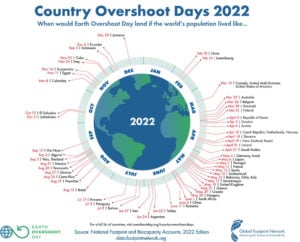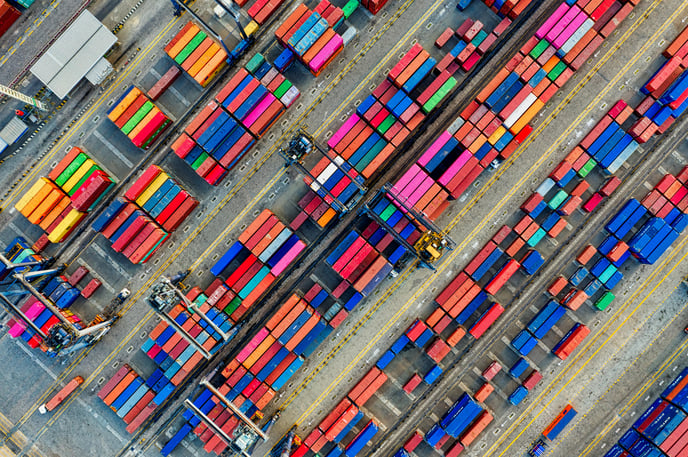Celebrating Earth Day – 6 Ways to a Sustainable Supply Chain
A birthday is supposed to be a celebration. However, as #EarthDay2022 approaches its 51st anniversary, with the reality of Overshoot Days – Ireland, where I live shot past its Overshoot Day just yesterday – and a realisation that we are far away from the targets set by the Paris Agreement, there is some work ahead of us. We will have to wish very hard.

However, there are reasons to be hopeful. There are numerous good things happening already, and a whole range of things we can do today.
Many corporate sustainability initiatives and efforts to “go green” are happening through every industry; There is an increasing focus on minimising the depletion of our natural resources and reducing our Greenhouse Gases. Cohorts from all corners are pressing us to focus on ethical practices. There is increasing pressure from investors, shareholders, customers, legislators to have climate strategies and plans in place to achieve verifiable improvements.
The impact of change is approximately 7 times greater when our whole supply chain is involved than when we act alone as a single business. Collaboration with the supply chain is the best way to leverage that potential. We are only as strong as the weakest link in the chain. We have experienced this since Brexit, since COVID and we are facing it with the continued and unjust war in Ukraine.
- Have you considered how the sustainability of your supply chain?
- Does your business ask the right questions from your suppliers to achieve your targets for sustainable growth?
- Do your suppliers offer you sustainable solutions as alternatives to your current practices or products?
Challenging yourself and your suppliers is the right thing to do. The need to collaborate and learn from each other has never been greater.
Here are 6 ways your business can influence your supply chain to be more sustainable.
1. Map your current supply chain from cradle to cradle.
Transparency and traceability are the core principles of a sustainable supply chain. Suppliers represent most of a company’s spend for most of the industries. A simple Kraljic exercise will allow you to understand who you most impact and who has the biggest impact on your business. The 80-20 analysis will allow you to focus where it matters.
Understanding your starting point is important for any change program. This applies to you knowing what goes into your products, where the raw materials are coming from and who the suppliers are. Many companies are not aware of all the links in their supply chain, and therefore they have no visibility on the risks, the opportunities, the sustainability impacts.
Develop your own supply chain map for the core products or services you sell. Understand the tiers of your suppliers and examine the current sustainable practices (or gaps) in place at your suppliers. Understanding what is of material importance to them is a best practice recommended by GRI (Global Reporting Initiative). A good example of understanding the value chain and the importance of sustainable topics is represented in this chart from Nike’s sustainability report.
2. Clarity is king: Sustainable expectations should be set for your supply chain
Communication is key within any business and supply chain.
From the inception of need to the termination of a contract, you should ensure that your communication (policies, procedures, supplier code of conduct, contracts, development programs, SLA, KPIs, …) are all telling the same story.
It is your responsibility to take the lead on being crystal clear on how you expect the supplier to perform and behave.
3. Pre-qualifying Questionnaires: Is Sustainable a “Must Have” or “Nice to Have”?
Throughout the procurement lifecycle, different documents can ensure that the buyer and the seller are both clear, and transparency and fairness are core principle for the buying and selling activities.
While perhaps not always the easiest process in which to engage, the public sector has very stringent rules in place and supporting processes and documents to ensure this can be achieved. Clarity is good.
When we think about the Request for Information (RFI) or the Pre-qualification Questionnaire (PQQ), we all have the opportunity, buyer and seller alike to express our expectation of sustainable behaviour and solutions in a different way. This step in the buying process is extremely valuable when it comes to requesting sustainable standards, qualifications, experience or practices as part of what is important.
4. Collaborate to innovate: Extend your sustainable training programs to your supply chain
If the climate crisis has taught us anything, it is that we are all in this journey together. If you have not done so already, you should start engaging with your main suppliers to understand what they have in place to address for example their Greenhouse Gases (GHGs), their own supply chain ethical conducts, their waste and water and product footprints.
We can all learn from each other but taking the lead to share best practices from and with your main suppliers will accelerate the impact you and your suppliers can have on the extended chain. Collaborate across all your links to strengthen your chain and influence upstream and downstream. This in turn will help achieve your own sustainable goals and it will help achieve the suppliers’ goals as well.
5. What gets measures, gets improved: Agree disclosures and provide evidence of the change
Too many greenwashing stories have diminished the good work that lots of companies have done in the past. Let’s face it, we all tell a good story, but we also know that a story is just a story if we can’t back it up by data.
- More and more regulations are coming online to ensure we can demonstrate the due diligence that is required to back up our disclosures.
- More and more investors are demanding scenario-based analysis that informs growth plans with performance targets and clear evidence that the right decisions are being made, with a focus on addressing a Triple Bottom line (Economic, Environmental and Social optimised decisions).
- Academia and global NGOs have given us a myriad of great frameworks to use and measure against. Let’s use them and put the right governance model in place for our suppliers to be able to have verified disclosures of which we can all be proud.
6. Sharing is caring: Let’s co-operate across industry to safeguard Mother Earth
Currently we are experiencing the tragedy of the commons. There is limited resource to go around. When one group of people use an unfair share, others suffer.
We are all not on the same page and too many loopholes are still being used by too many companies so that they do not have to change their business model.
When a select few take limited resources from all, we are dealing with an unjust world. When we learn from each other and we can agree we want Mother Earth to survive and flourish, we then we need to align to the same principles.
Future Planet believes in the Seventh Generation Principles of the old Iroquois tribe which paraphrased goes like this: ‘the decisions we make today should result in a sustainable world seven generations into the future.’
If we can all sign up to that, our business, our suppliers, our customers, then we have a common ground to make the right buying, selling and consumption decisions.
The customer is the planet, and that’s a customer relationship we want to nourish.
Happy #Earthday2022
